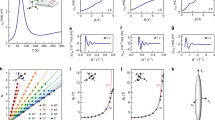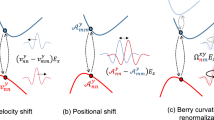Abstract
The effect of spin-orbit coupling of conduction electrons on the Hall coefficient of liquid metals is studied and a new mechanism for the anomalous Hall coefficient is suggested. S.O. coupling causes asymmetric scattering and a current, perpendicular to the magnetic field and to the electric field, is set up. This leads to an additional Hall coefficient\(\tilde R_{so} \), as was first calculated by Luttinger. But S.O. coupling also causes a dipole to appear near each ion, leading to an electrical polarization and an additional Hall coefficient,R so.R so is calculated for liquid normal metals and transition metals to first order in S.O. coupling. In normal metals,R so and\(\tilde R_{so} \) are proportional to the Pauli susceptibility. Both are positive for electron-like charge carriers. S.O. coupling leads to a maximum deviation from nearly free electron value in the Hall coefficient of a heavy, four or five-valent liquid metal with short mean free path. In transition metals, different expressions are obtained forR so depending whether localized moments are present (magnetic model) or not (non-magnetic model). The sign ofR so is determined by the value of thed-phase shift alone.R so is proportional to the susceptibility ofd-electrons and can be large, leading to a positive Hall coefficient in the liquid transition metal.
Similar content being viewed by others
References
Anderson, J. R., Gold, A. V.: Phys. Rev. A139, 459 (1965).
Anderson, P. W.: Phys. Rev.124, 41 (1961).
Animalu, A. O. E.: Phil. Mag.11, 379 (1965).
Animalu, A. O. E.: Phil. Mag.13, 53 (1966).
Animalu, A. O. E., Heine, V.: Phil. Mag.12, 1249 (1965).
Argyres, P.: Phys. Rev.117, 315 (1960).
Baltensperger, W.: Phys. kondens. Materie5, 115, 341 (1966).
Busch, G., Güntherodt, H.-J.: Phys. kondens. Materie6, 325 (1967).
Busch, G., Güntherodt, H.-J., Künzi, H. U., Schlapbach, L.: Phys. Letters A31, 191 (1970).
Busch, G., Güntherodt, H.-J., Künzi, H. U.: Phys. Letters A32, 376 (1970).
Busch, G., Güntherodt, H.-J., Künzi, H. U.: Phys. Letters A34, 309 (1971).
Busch, G., Yuan, S.: Phys. kondens. Materie1, 37 (1963).
Chan, T., Ballentine, L. E.: Phys. Letters A35, 385 (1971).
Coqblin, B., Blandin, A.: Adv. Phys.17, 281 (1968).
Coqblin, B.: French German Colloquium on Supercond.
Dupree, R., Geldart, D. J. W.: Solid State Commun.9, 145 (1971).
Edwards, S. E.: Proc. roy. Soc.A 267, 518 (1972).
Evans, R.: J. Phys. C (Suppl.)2, 5137 (1970).
Evans, R.: Phys. Chem. Liquid2, 249 (1971).
Evans, R., Greenwood, D. A., Lloyd, P.: Phys. LettersA 35, 57 (1971).
Evans, R., Deirach, O., Güntherodt, H.-J., Künzi, H. U.: J. Phys. F2, 709 (1972).
Fert, A., Jaoul, O.: Phys. Rev. Letters28, 303 (1972).
Fournier, J. M.: Ann. Phys.6, 159 (1971).
Friedel, J.: Nuovo Cimento7, 287 (1958).
Friedel, J.: In: Physics of Metals, Vol. I. Cambridge: University Press 1969.
Friedman, L.: J. non-cryst. Solids6, 329 (1971).
Fukuyama, H., Ebisawa, H., Wada, Y.: Progr. theor. Phys.42, 494 (1970).
Gerhardts, R., Hajdu, J.: Solid State Commun.8, 1631 (1970).
Greenfield, A. J.: Phys. Rev.135, A 1589 (1964).
Gschneider, K. A.: J. Less Common Metals25, 405 (1971).
Gyorffy, B., Szabo, N.: to be published (1972).
Hajdu, J., Keiter, H.: Z. Phys.201, 507 (1967).
Herman, F., Skillman, S.: Atomic Structure Calculations. Prentice Hall 1963.
Hubbard, J.: Proc. roy. Soc.A 281, 401 (1964).
Hurd, C. M.: The Hall Effect in Metals and Alloys. Plenum Press 1972.
Keller, J., Jones, R.: J. Phys. F1, L 33 (1971).
Kittel, C.: Quantum Theory of Solids. New York: J. Wiley & Sons 1963.
Künzi, H. U.: Diss. ETH 1972, to be published.
Lehman, G. W.: Phys. Rev.116, 848 (1959).
Lenglart, P.: Ann. Phys.3, 27 (1968).
Levin, K., Bennemann, K. H.: Phys. Rev. B5, 3770 (1972).
Likhter, A. I., Venttsel, V. A.: Soviet Physics Solid State4, 352 (1962).
Luttinger, J. M., Kohn, W.: Phys. Rev.108, 590 (1957).
Luttinger, J. M., Kohn, W.: Phys. Rev.109, 1892 (1958).
McPherson, M. R., Everett, G. E., Wohlleben, D., Maple, M. B.: Phys. Rev. Letters26, 20 (1971).
Meier, H. A.: Diss. ETH (1972), to be published.
Messiah, A.: Quantum Mechanics, North Holland (1969).
Morgan, G. J.: J. Phys. C2, 1446, 1454 (1969).
Rice, T. M.: Phys. Rev.175, 858 (1968).
Rodberg, L. S., Thaler, R. M.: Introduction to Quantum Theory of Scattering. Academic Press (1967).
Schafroth, M. R.: Helv. phys. Acta24, 645 (1952).
Shaw, R. W., Harrison, W. A.: Phys. Rev.163, 604 (1967).
Silverstein, S. D.: Phys. Rev.130, 912 (1963).
Souletie, J.: J. Low Temp. Phys.7, 141 (1972).
Stoner, E. C.: Rep. Progr. Phys.9, 43 (1946).
Sundström, L. H.: Phil. Mag.11, 657 (1965).
Szabo, N.: To be published (1972).
Volonshinskii, A. N., Shelushinina, N. G.: Soviet Physics Solid State13, 1060 (1971).
Weisz, G.: Phys. Rev.149, 508 (1966).
Wilson, A. H.: Proc. roy. Soc.190, 439 (1947).
Yafet, Y.: J. appl. Phys.39, 853 (1968).
Yafet, Y.: J. appl. Phys.42, 1564 (1971).
Ziman, J. M.: Phil. Mag.6, 1013 (1961).
Ziman, J. M.: In: Properties of Liquid Metals. Taylor & Francis 1966.
Literature on the Anomalous Hall Effect
Jan, J. P.: Helv. phys. Acta25, 677 (1952).
Pugh, M., Rostoker, N.: Rev. mod. Phys.25, 151 (1953).
Luttinger, J. M.: Phys. Rev.95, 1154 (1954).
Smit, J.: Physica21, 877 (1954).
Luttinger, J. M.: Phys. Rev.112, 739 (1958).
Smit, J.: Physica24, 39 (1958).
Irkhin, Y. P., Shavrov, V. G.: J.E.T.P.15, 854 (1962).
Kondo, J.: Prog. theor. Phys.27, 772 (1962).
Kondorskii, E. I., Cheremushkina, A. V., Kurbaniyazov, N.: Soviet Physics Solid State6, 422 (1964).
Irkhin, Y. P. Volonshinskii A. N., Abelskii, S. S.: Phys. Status Solidi22, 309 (1967).
Maranzana, F. E.: Phys. Rev.160, 421 (1967).
Rhyne, J. J.: Phys. Rev.172, 523 (1968).
Christoph, V.: Phys. Status Solidi26, K 17 (1968).
Lin, S. C. H.: J. appl. Phys.40, 2175 (1969).
Kondorskii, E. I.: J.E.T.P.28, 291 (1969).
Abelskii, S. S., Irkhin, Y. P.: Soviet Physics Solid State10, 1768 (1969).
Fedorov, G. V., Volkenshtein, N. V.: Soviet Physics Solid State12, 1079 (1970).
Berger, L.: Phys. Rev. B2, 4559 (1970).
Giovannini, B.: Phys. LettersA 36, 381 (1971).
Fert, A., Jaoul, O.: Phys. Rev. Letters28, 303 (1972).
Berger, L.: Phys. Rev. B5, 1862 (1972).
Leroux, P., Ghazali, A.: J. Phys. C5, 1072 (1972).
Lyo, S. K., Holstein, T.: Phys. Rev. Letters29, 423 (1972).
Author information
Authors and Affiliations
Rights and permissions
About this article
Cite this article
ten Bosch, A. A new mechanism for the anomalous hall coefficient with application to liquid metals. Phys kondens Materie 16, 289–318 (1973). https://doi.org/10.1007/BF02423362
Received:
Issue Date:
DOI: https://doi.org/10.1007/BF02423362




